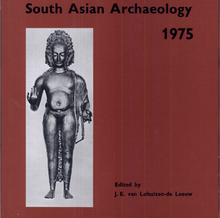Brahma from Mirpur-Khas
The Brahma from Mirpur Khas is a famous bronze image of Brahma made in Sindh, in modern Pakistan, dated to the 5th or 6th century, during the Gupta period.[1] It is the earliest known [2] metallic image of Brahma and the only known representative of the school it represents.[3] It has been described as "an immense artistic creation" of the Gupta period.[4]

| Brahma from Mirpur Khas | |
|---|---|
| Material | Bronze/Copper |
| Size | Height: 95 cm Width: 53 cm |
| Period/culture | c. 5th or 6th century |
| Place | Sindh, Pakistan |
| Present location | Pakistan |
It was found in a field near Mirpur-Khas as first reported by Henry Cousens in 1929.[5][6] Some report it as having been found at Brahmanabad.[7]
Description
The four-headed Brahma bronze statue has a height over 3 feet. Brahma is shown standing with two hands, wearing a dhoti and a yajnopavita but without any ornaments.[8] Vasudeva Sharana Agrawala calls it "an exceptionally good specimen of the art of metal-casting in this period".[9] Śrīrāma and Śaṅkara Goyala term is "true memorial of Gupta metalsmith's artistic genius".[10] It is said to the best example of Gupta art in Sindh.[11]
The object suggests that Sindh was a major center of metalworking.[12]
It is at The National Museum Karachi In beautiful Gallery.
Comparison with related art
Brahma from Mirpur Khas has been widely used by art historians for comparison with other artwork of historical significance.[13]
References
- Indian Art of the Gupta Age: From Pre-classical Roots to the Emergence of Medieval Trends, Editors Śrīrāma Goyala, Śaṅkara Goyala, Kusumanjali Book World, 2000, p. 85
- Essays on Buddhist, Hindu, Jain Iconography & Epigraphy, Gouriswar Bhattacharya, International Centre for Study of Bengal Art, 2000, p. 236
- Early Brass Image of Bodhisattva, J.C. Harle, in South Asian Archaeology 1975: Papers from the Third International Conference of the Association of South Asian Archaeologists in Western Europe Held in Paris, J. E. Van Lohuizen-De Leeuw, BRILL, 1979 p. 134
- Arts of Asia, Volume 4 Publisher Arts of Asia, 1974, p. 110, The immense artistic creation of the period was distinguished by the exercise of greater restraint, elegance of form and spiritual expression.
- The Antiquities of Sind: With Historical Outline, Henry Cousens, Bhartiya Publishing House, 1929 - Sindh (Pakistan) p.10
- Sind Quarterly, Volume 8, Contributor Shah Abdul Latif Cultural Society, Publisher Mazhar Yusuf, 1980, p.24 "absolutely magnificent brass image of Brahma (7i) from the neighbourhood of Mirpur Khas".
- Five deities of Panchopasana, G. Bhattacharya, in Studies in Hindu and Buddhist Art edited by P. K. Mishra, p. 199-200
- Indian Costume, Govind Sadashiv Ghurye, Popular Prakashan, 1966, Figure 100.
- Indian Art - Volume 2, Vasudeva Sharana Agrawala, Prithivi Prakashan, 1977, Page 43
- Indian Art of the Gupta Age: From Pre-classical Roots to the Emergence of Medieval Trends, Editors Śrīrāma Goyala, Śaṅkara Goyala, Kusumanjali Book World, 2000, p. 85
- Vakataka - Gupta Age Circa 200-550 A.D., Ramesh Chandra Majumdar, Anant Sadashiv Altekar, Motilal Banarsidass Publ., 1967, p. 435
- Objects of Translation: Material Culture and Medieval "Hindu-Muslim" Encounter, Finbarr Barry Flood, Princeton University Press, 2009, p. 50
- South Asian Archaeology 1975: Papers from the Third International Conference of the Association of South Asian Archaeologists in Western Europe Held in Paris, J. E. Van Lohuizen-De Leeuw BRILL, 1979. The image of the Brahma from Mirpur Khas is on the cover. https://books.google.com/books?id=H2GW1PTHQ1YC&printsec=frontcover&source=gbs_ge_summary_r&cad=0#v=onepage&q&f=false